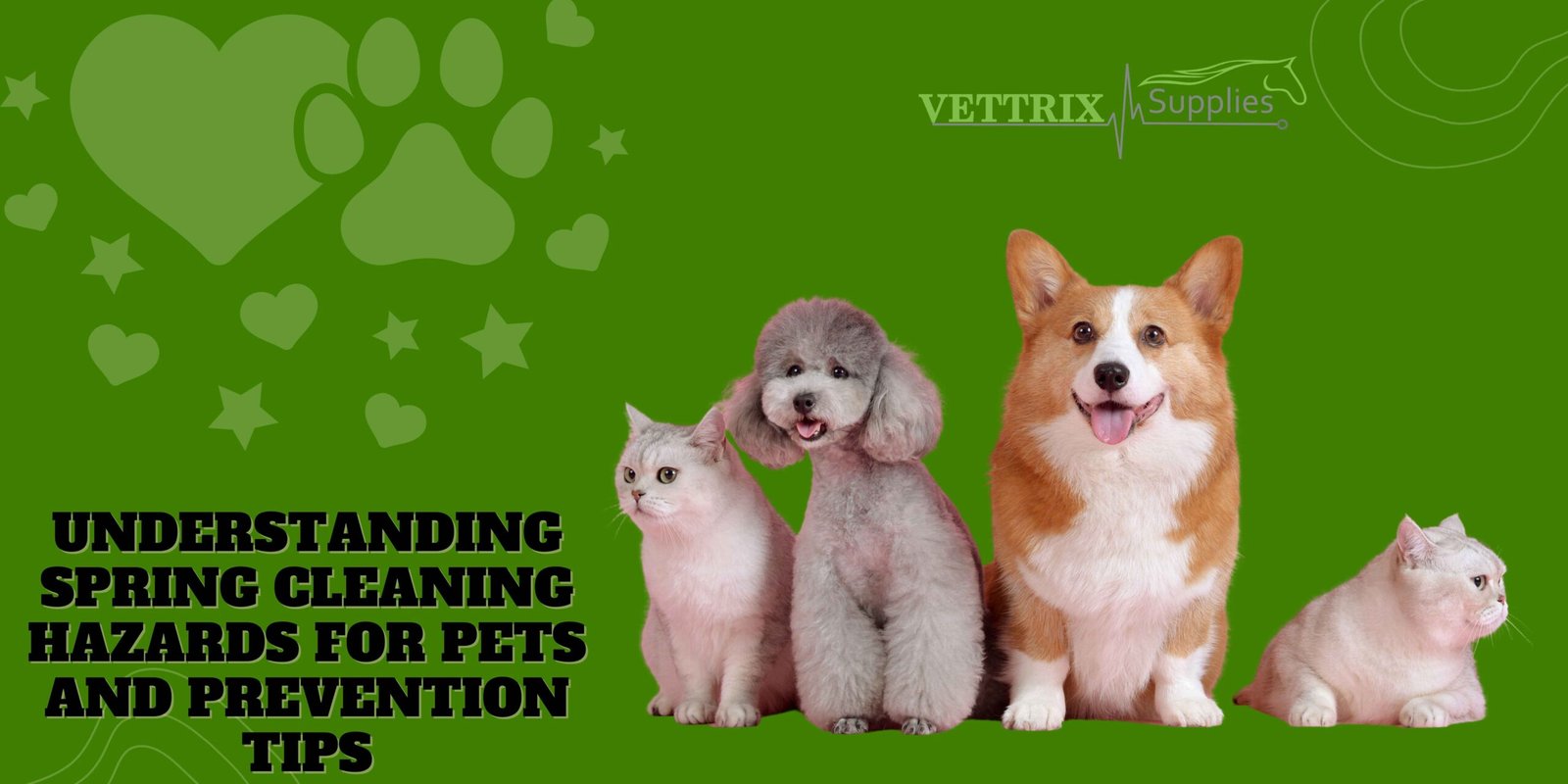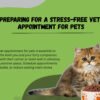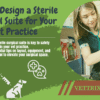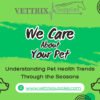Understanding Spring Cleaning Hazards for Pets and Prevention Tips
Spring cleaning involves deep scrubbing, disinfecting, and rearranging that can introduce new hazards to a pet’s environment. These activities often increase exposure to noxious substances, disrupt familiar layouts that pets rely on for safety, and occur in areas with reduced airflow. Understanding how each factor contributes to risk will inform strategies to keep animals safe.
Increased exposure to harmful chemicals
Using bleach, ammonia, and high-strength disinfectants releases fumes and leaves residues that pets may ingest or inhale. These substances can cause gastrointestinal irritation if licked off floors or skin burns on paw pads. Veterinarians note that even dilute solutions can provoke vomiting, diarrhea, and respiratory distress in sensitive species. Pet-free zones during application and thorough rinsing help prevent accidental contact and ingestion.
Chemical Exposure Risks for Pets Exposure to household chemicals can lead to various health issues in pets, including gastrointestinal irritation, skin burns, and respiratory distress [1]. Diluted solutions of common cleaning agents like bleach and ammonia can still cause adverse reactions, emphasizing the need for pet-safe cleaning practices [1]. Thorough rinsing and pet-free zones reduce these risks.
Pets’ curiosity during routine changes
Pets explore new layouts instinctively, sniffing drawers, under furniture, or behind appliances moved for cleaning. Displaced items like laundry pods or spray bottles can become play objects, heightening ingestion or breakage risk. Supervising pets away from work areas and confining them to safe zones maintains familiarity and curtails exploratory hazards.
Lack of ventilation and enclosed spaces
Cleaning closets, attics, or basements often lacks proper airflow, concentrating vapors from solvents, mold sprays, and aerosolized pest control products. When pets enter these confined spaces during or immediately after treatments, they may suffer acute toxicity. Always ventilate for at least 30 minutes post‐cleaning or use low-odor, non-aerosol alternatives before reintroducing animals.
Pets face poisoning when they come into contact with household cleaners containing corrosive or neurotoxic compounds. Recognizing and eliminating these harmful products is crucial for accident prevention.
Bleach, ammonia, and other harsh disinfectants
Bleach (sodium hypochlorite) and ammonia interact to produce chloramine gases that damage respiratory mucosa. Direct ingestion causes corrosive burns to the mouth and esophagus. Veterinary toxicology protocols stress substituting these with peroxide-based or plant-derived disinfectants to maintain microbial control without risking pulmonary or dermal injury.
Toxic Cleaning Agents and Their Effects Many household cleaning products contain corrosive or neurotoxic compounds that can poison pets [2]. When mixed, bleach and ammonia create chloramine gases damaging the respiratory system, while direct ingestion can cause burns [2]. This underscores the need to avoid harsh chemicals and switch to safer alternatives.
Fabric softeners and laundry pods
Laundry pods concentrate surfactants, fragrances, and dyes within a chewable membrane. Ingestion leads to severe gastrointestinal upset, central nervous signs, and even aspiration pneumonia if vomited. Practitioners recommend using fragrance-free, dye-free detergents in powder or liquid form stored securely out of pet reach.
DIY cleaners that can be unsafe for pets
Homemade mixes often combine vinegar, essential oils, or borax in unsafe ratios. Essential oils such as tea tree or citrus oil contain monoterpenoids that provoke salivation, tremors, and liver injury in cats. Vettrix Supplies’ certified pet-safe DIY spray recipes use only water, baking soda, and pet-approved citrus extracts for both efficacy and safety.
Transitioning to natural, vetted cleaning solutions eliminates most chemical hazards while preserving hygiene standards required in clinical and home settings.
Natural cleaning agents (baking soda, vinegar, etc.)
Baking soda neutralizes odors and scrubs surfaces without abrasiveness, while diluted white vinegar dissolves mineral deposits and bacteria. A 1:4 vinegar-water solution cleans tile and glass effectively. These ingredients pose negligible toxicity if pets come into contact, though vinegar fumes can irritate airways so proper ventilation is advised.
Pet-Safe Cleaning Alternatives Natural cleaning solutions can eliminate chemical hazards while maintaining hygiene [3]. Baking soda and diluted white vinegar are effective and minimally toxic to pets [3]. These alternatives reduce the risk of poisoning and create a safer environment.
Vet-recommended pet-safe brands
Several reputable brands formulated for veterinary environments guarantee non-toxic, hypoallergenic ingredients.
Product Feature Benefit Vettrix Pet+ Clean Spray Plant-based surfactants Removes grime and deters pests Lenox Vet Floor Guard Enzyme-based formula Neutralizes organic stains without fumes Canvet Academy Surface Gel Fragrance-free, non-residue Safe for kennels and bedding
Each product passes rigorous safety testing to minimize skin, respiratory, and ocular irritation in companion animals.
How to make your own safe cleaning sprays
Combine 2 cups of water with ½ teaspoon of dish soap (free of dyes and perfumes) and 1 tablespoon of baking soda. Add a few drops of food-grade citrus extract for scent, then store in a labeled spray bottle. This low-odor solution tackles light soils while posing minimal ingestion or inhalation risk to pets.
Even non-chemical items can threaten pets when disturbed or displaced during spring decluttering.
Small objects and choking risks
Loose screws, buttons, beads, or coins can become hidden beneath moved furniture, leading to airway obstruction if swallowed. A systematic floor sweep and using a handheld vacuum before dismantling areas help remove hazardous debris.
Plastic bags, cords, and packing materials
Bags and stretch wrap attract curious pets and pose risks of suffocation or intestinal blockage if ingested. Organize these items in sealed bins with lids, and immediately discard excess packaging in outdoor trash receptacles to prevent scavenging.
Open windows and screen dangers
Cleaning window panes or frames often involves propping sashes open, which can expose screens that may tear under pet weight. Always secure screens with clips rated for pet use and close windows when animals are nearby to minimize fall and escape risks.
Spring introduces toxic flora and soil treatments that can lead to severe poisoning when pets nibble or dig.
Common toxic spring plants for pets
Azaleas, lilies of the valley, and sago palms contain toxins that cause vomiting, hypotension, and liver failure. Even small ingestions demand immediate veterinary evaluation. Replace these ornamentals with non-toxic varieties such as Boston ferns or spider plants to maintain greenery without risk.
Mulch and fertilizers toxicity
Steel-wool and cocoa bean mulch contain theobromine, provoking cardiac signs and seizures in dogs. Fertilizers enriched with metaldehyde slug bait or insect growth regulators may lead to neurological symptoms.
Substance Toxic Component Effect Cocoa mulch Theobromine Tachycardia, tremors Metaldehyde bait Metaldehyde Ataxia, seizures Lawn fertilizer N-phosphates Gastroenteritis, dehydration
Choosing pet-safe cedar or pine bark mulch and eco-certified fertilizers can prevent accidental poisoning during gardening.
Indoor potted plant soil and pests
Potting soils can harbor insect larvae, mold, or bacteria such as leptospirosis agents. Pets digging in planters risk skin irritation or gastrointestinal infection. Use pet barriers around planters and rinse soil with a mild, pet-safe disinfectant before outdoor exposure.
Air fresheners and scented candles emit volatile organic compounds (VOCs) and aerosols that can provoke respiratory and dermatologic issues in animals.
Respiratory issues caused by aerosols
Aerosol sprays send fine droplets deep into the lungs, triggering coughing, sneezing, or asthma-like episodes in cats and small mammals. While plug-in diffusers emit fewer particulates, those with phthalates remain inadvisable. Instead, use passive odor absorbers like activated charcoal pouches placed out of pets’ reach.
Essential oils to never use around pets
Oils such as tea tree, eucalyptus, citrus, and cinnamon contain compounds that induce vomiting, ataxia, and liver damage. Even topical diffusion can cause skin hypersensitivity. Always refer to veterinary toxicology databases before introducing any scent.
Safer ways to freshen your home
Boil water with fresh rosemary or mint sprigs on the stove, then cool and lightly spray in empty rooms. Alternatively, leave bowls of baking soda with a few drops of pet-safe essential oils (e.g., lavender in dilute concentrations) to naturally absorb odors.
Proper storage and disposal techniques during decluttering can eliminate physical hazards and reduce toxic exposures.
Secure storage for sharp and hazardous items
Knives, scissors, and hobby tools should be stored in lockable cabinets. Keep all cleaning solutions on high shelves or in locked cupboards clearly labeled with warning symbols to prevent accidental punctures or ingestion.
Keeping breakables out of reach
Glass vases and ceramic ornaments can shatter under pet paws, leading to lacerations and ingestion of shards. Store fragile items in closed boxes on higher racks and use soft-close drawers to avoid startling pets during access.
Safe disposal of expired products
Expired medications, chemicals, and pesticides must be sealed in their original containers and returned to pharmacies or hazardous waste programs. Leaving them in household trash may invite pets to chew through packaging, causing poisoning and gastrointestinal injury.
Structured zoning and organized storage dramatically reduce indoor exposure risks during intensive cleaning.
Setting up pet-free zones during cleaning
Designate rooms where cleaning is in progress as off-limits by using baby gates or closed doors. Ensure these areas include water, bedding, and toys to reduce stress and keep pets away from fresh spills or residues.
Cleaning product storage best practices
Store all detergents, disinfectants, and polishes in child-proof cabinets fitted with magnetic locks. Label secondary containers clearly with product names and hazard icons, and maintain an inventory sheet near storage areas for rapid identification during emergencies.
Symptoms of exposure or poisoning in pets
Monitor for signs such as drooling, excessive paw licking, vomiting, diarrhea, tremors, coughing, or skin redness. Neurological signs like ataxia or seizures indicate severe toxicity. Early recognition and prompt veterinary assessment can greatly improve outcomes through timely decontamination and care.
A well-stocked first aid kit designed for spring cleaning exposures equips caregivers to respond immediately to chemical contacts and injuries.
Must-have items for emergency situations
Include saline eye wash, activated charcoal tabs, protective exam gloves, bandage material, antiseptic wipes, and a digital thermometer. A veterinary-grade chemical-contact protocol card detailing neutralizing agents and decontamination steps further enhances readiness for ingestion or skin exposures.
How to use items in case of chemical contact
If a pet’s eyes or skin come into contact with bleach or ammonia, flush the area with lukewarm saline for at least 10 minutes before seeking veterinary treatment. For ingestion, administer activated charcoal at 1–3 g/kg body weight under professional guidance to bind any residual toxins in the gastrointestinal tract.
When to call your vet or emergency clinic
Immediately contact a veterinarian if a pet exhibits persistent vomiting, seizures, labored breathing, inability to stand, or signs of corrosive burns. Having sample packaging or ingredient labels on hand can expedite toxicological assessment and targeted intervention.
Embedding pet-safety protocols into a cleaning schedule ensures consistent protection and reduces the likelihood of oversight.
Scheduling when pets are out or distracted
Arrange deep-cleaning tasks when pets are at daycare, during grooming appointments, or while they play outdoors under supervision. This minimizes direct exposure and prevents interference with cleaning processes without compromising their social or exercise needs.
Routine checklists for pet safety
A structured checklist ensures every step—from securing hazardous items to ventilating rooms—is followed systematically. Example steps include locking cabinets, covering vents, confirming window screens, and verifying proper storage of chemicals before allowing pets back in.
Involving the family in hazard awareness
Educate all household members about pet-specific risks to enhance vigilance. Post a visible hazard map near the laundry and cleaning supply area, detailing “no‐go” zones and emergency contact information for quick reference during spring cleaning activities.
Knowing exact indicators for veterinary intervention ensures timely treatment and prevents complications from delayed care.
Signs of poisoning or skin irritation
Signs such as drooling, pawing at the mouth, erythema, hair loss, or blistering on pads signal chemical burns. Systemic poisoning may present with lethargy, tremors, diarrhea, and jaundice if liver injury occurs. Early recognition facilitates immediate decontamination.
Bringing in samples or packaging
Transport any remaining cleaning product containers, labels, or plant material to the clinic. These samples help toxicologists quickly identify agents, determine appropriate antidotes, and predict clinical outcomes.
Long-term impacts of chemical exposure
Chronic low-grade inhalation of VOCs may lead to respiratory sensitization, chronic cough, or aggravated allergies, while repeated skin exposures risk barrier disruption and secondary infections. Regular monitoring and follow-up examinations help mitigate lingering effects and preserve long-term pet health.








Add comment